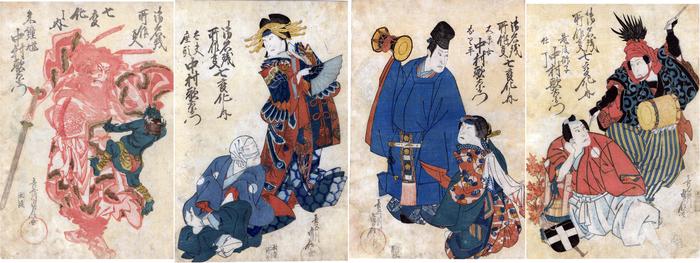Hasegawa Sadanobu I (初代長谷川貞信) (artist 1809 – 1879)
Nakamura Utaemon IV (中村歌右衛門) in multiple roles from the series Renowned Dance of Seven Changes (Onagori shosagoto nanabake shichihenge no uchi - 御名残所作事七変化之内)
01/1838
38 in x 14 in (Overall dimensions) Japanese woodblock print
Signed: Hasegawa Sadanobu ga
長谷川貞信画
Seal: Tokubei
Publisher: Honya Seishichi (Marks 123 - seal 25-527)
and possibly another unidentified publisher's seal
Museum of Fine Arts, Boston - second print in from the right
Museum of Fine Arts, Boston - print on far right
Museum on Fine Arts, Boston - print on far left
Hankyu Culture Foundation - far left panel only
Hankyu Culture Foundation - far right panel only
Hankyu Culture Foundation - 2nd from left panel only
Hankyu Culture Foundation - 2nd from right panel only
National Museum of Japanese History (via Ritsumeikan University) - 1833 Kunisada of Shoki with a demon Four sheets from a set, complete: (from left to right)
Nakamura Utaemon IV a red Shōki (朱鍾馗), as a tayū (太夫) or high ranking courtesan and a zatō (座頭) or blind masseur, as Ōharame (大原女) and Narahira (なり平) and as Echigo jishi (越後獅子) or Echigo lion dancer and a jichō (仕丁) or palace servant
****
"As the grand finale to his farewell performance, Utaemon IV presented a set of seven changes, of which the role of Shōki was the last. This was probably patterned on the performance of Utaemon III in 1829... Here, however, the artist has used metallic pigments - silver on the sword and brass on the figure - to offset the ethereal quality of the main figures, and the queller of demons grasps a delightful struggling demon, quite solidly printed with metallic details, by the throat. The print announces the farewell performance in the upper right."
Quoted from: Osaka Prints by Dean Schwaab, p. 181.
****
In 'Ryusai Shigeharu: 'Quick change' dances in the Utaemon tradition' by John Fiorillo and Peter Ujlaki in Andon 72 & 73, October, 2002, p. 118 the authors wrote:
Nakamura Utaemon lV (1796-1.852) was the son of an Edo teahouse owner. He studied with a master choreographer, his uncle Fujima Kanjūro I, and worked as one himself in1,807, which prepared him well for his mature dance performances of hengemono.In 1811, while working as Nakamura Fujitarō, he took lodgings in the home of Utaemon III, and then, in 1813, he changed his name to Nakamura Tsurusuke and performed in the smaller theaters in Osaka. While 'troupe head' (zagashira) at the Nakamura Theater, Edo, in 1.827 , his lavish lifestyle resulted in his being punished for violating sumptuary edicts. Then in 1836 he was formally adopted by Utaemon III, becoming Utaemon IV. Like his adoptive father, he excelled as a kaneru yakusha, and although he did not quite attain the exalted status of Utaemon III, he still possessed the skills required to play the many types of characters in nanabake with convincing realism and stylized grace.****
Illustrated:
1) in color in Ikeda Bunko, Kamigata yakusha-e shūsei, vol. 3, Osaka, 2001, No 15.
2) in color in Osaka Prints by Dean Schwaab, Rizzoli, 1989, page 183. This image is only of the left-hand panel of Shōki the Demon Queller.
****
There is another copy of the second print in from the left in the Kansai University Library.
****
A curious case for connoisseurs
There are at least three other examples of these prints in the Lyon Collection which are also represented in the collection of the Museum of Fine Arts in Boston. Their example of the far left image of Shōki quelling a demon is in slightly better condition.
Nakamura Utaemon IV (四代目中村歌右衛門: 1/1836-2/1852) (actor)
Kyōto-Osaka prints (kamigata-e - 上方絵) (genre)
actor prints (yakusha-e - 役者絵) (genre)
Shōki (鍾馗), the Demon Queller (role)
